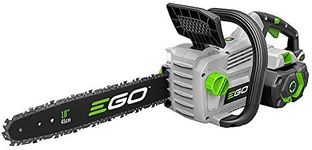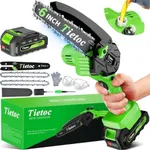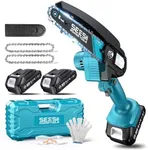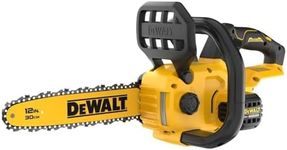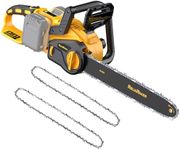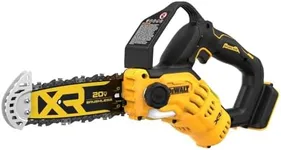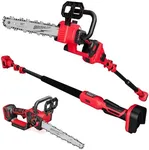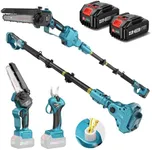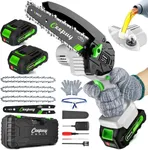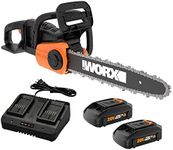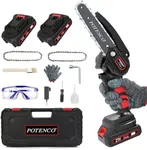Buying Guide for the Best Battery Chainsaws
Choosing the right battery chainsaw can make your yard work or tree cutting tasks much easier and more efficient. When selecting a battery chainsaw, it's important to consider several key specifications to ensure you get a model that fits your needs. Understanding these specs will help you make an informed decision and find a chainsaw that offers the right balance of power, runtime, and convenience for your specific tasks.Battery VoltageBattery voltage indicates the power output of the chainsaw. Higher voltage typically means more power, which is important for cutting through thicker or harder wood. Battery chainsaws usually come in voltages ranging from 18V to 80V. For light pruning and small branches, a lower voltage (18V-36V) may suffice. For medium to heavy-duty tasks, such as cutting firewood or felling small trees, a higher voltage (40V-80V) is recommended. Choose a voltage based on the type of work you plan to do most often.
Battery Capacity (Ah)Battery capacity, measured in ampere-hours (Ah), determines how long the chainsaw can run on a single charge. A higher Ah rating means a longer runtime. Battery capacities typically range from 2.0Ah to 5.0Ah or more. For occasional use or smaller tasks, a lower capacity battery (2.0Ah-3.0Ah) may be sufficient. For extended use or larger projects, a higher capacity battery (4.0Ah-5.0Ah or more) will provide longer operation time without needing frequent recharges. Consider how long you need the chainsaw to run between charges when selecting battery capacity.
Bar LengthThe bar length of a chainsaw determines the maximum diameter of wood it can cut in a single pass. Common bar lengths for battery chainsaws range from 10 inches to 18 inches. For light pruning and trimming, a shorter bar length (10-12 inches) is usually adequate. For cutting larger branches, firewood, or small trees, a medium bar length (14-16 inches) is more suitable. For heavy-duty tasks, such as felling larger trees, a longer bar length (16-18 inches) may be necessary. Choose a bar length based on the size of the wood you will be cutting most frequently.
Chain SpeedChain speed, measured in feet per second (fps) or meters per second (m/s), affects how quickly and efficiently the chainsaw can cut through wood. Higher chain speeds result in faster cutting. Battery chainsaws typically have chain speeds ranging from 10 fps to 60 fps. For light-duty tasks, a lower chain speed (10-30 fps) may be sufficient. For more demanding tasks, such as cutting thick branches or logs, a higher chain speed (30-60 fps) will provide quicker and more efficient cutting. Consider the type of cutting you will be doing to determine the appropriate chain speed.
WeightThe weight of the chainsaw affects how easy it is to handle and maneuver. Lighter chainsaws are easier to use for extended periods and are less fatiguing, especially for overhead work. Battery chainsaws typically weigh between 6 to 15 pounds. For light pruning and occasional use, a lighter chainsaw (6-8 pounds) is ideal. For more frequent or heavy-duty use, a slightly heavier chainsaw (8-12 pounds) may offer better stability and cutting power. Consider your physical strength and the duration of use when choosing the weight of the chainsaw.
Safety FeaturesSafety features are crucial for preventing accidents and injuries while using a chainsaw. Common safety features include chain brakes, low kickback chains, hand guards, and automatic oiling systems. Chain brakes stop the chain quickly in case of kickback, while low kickback chains reduce the risk of sudden movements. Hand guards protect your hands from debris, and automatic oiling systems ensure the chain is properly lubricated. Look for chainsaws with these safety features to enhance your protection and make operation safer, especially if you are a beginner or using the chainsaw frequently.
